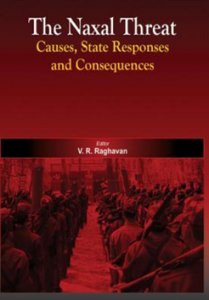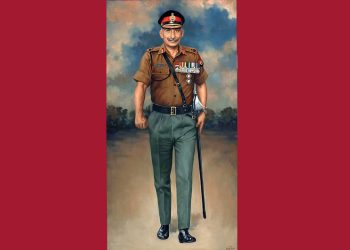
The book “The Naxal Threat: Causes, State Responses and Consequences” is edited by Lt Gen. (Retd) V.R. Raghavan and published by the Centre for Security Analysis, Chennai. It is an amalgamation of five distinct papers part of the “Internal Conflicts and Transnational Consequences’ seminar held in 2010 and authored by various luminaries. The book aims to “provide constructive and pertinent insight into the consequences on the tribal population, the challenges for the para-military forces as well as the perspective on the state’s response”.
The first chapter by Dr. Sudha Ramachandran is titled “The Maoist Conflict in Dandakaranya”. The author is an independent researcher/journalist. She has extensively written on South Asian politics and Security Issues and reported on India’s Maoist situation. The flair and grit of her journalistic capabilities lend a concentrated explanation to explore the complexities of insurgency.
The Dandakaranya region as a case study provides the author with maximum tangible causes and help in the construction and capture of the complexities of the Maoist conflict. First, the physiological features, she states, “[the region] A thickly forested and hilly area…includes the districts of Bastar, Dantewada and Kanker in Chhattisgarh; Gadchiroli and Chandrapur in Maharashtra; Koraput and Malkangiri in Orissa; and Adilabad, Karimnagar, Khammam and East Godavari districts in Andhra Pradesh”. Second, the region is mineral-rich. Third, the majority demographic accounts for tribal communities that live in abject poverty.
It explores three main themes; ‘Historicity and Evolution of the conflict’, ‘Consequences of the Response by state and Maoists’ and ‘Impact of the conflict on the India state’. The author explores different perspectives. It lays focus on the ideology, historicity and the consequences of the conflict. She argues that “the use of force by the State and the Maoists is deepening the intractability of the conflict”. Thus, it is essential“socio-economic programs must be implemented in a way that benefits reach the poorest sections of our society” as suggested by the author.
The second chapter titled “State Response to the Maoist Challenge: an Overview” authored by P V Raman. He is a research fellow in the Institute for Defence Studies and Analyses (IDSA), New Delhi. He has been involved in studying the Naxalite-Maoist movements in India and other South Asian countries. In 2005 he was consulted in the preparation report of the All India Congress Committee(AICC) Task Force on Naxalite Violence. At the outset of the paper, the author states that “the real aim of the Naxalites is neither the domain of economic nor state welfare”. It is a political movement that aims to seize political power. The paper’s objective is to present an “overview of the responses of the Union government and… the affected States to the Maoist challenge”. The approach of the author views the conflict as a power struggle between the Maoists and the state.
P V Raman explores the state’s response, he mentions the MHA Report of 1998 that suggested: “States to formulate a ‘holistic’ security and development plan to deal with the issue”. As per the author, respective states’ procrastination led to a major political failure. Its consequences led to the conflict’s growth and increase in violence by insurgents. The Chapter is divided into two themes, “Response of the Union Govt and State Govt”, discussed through the ‘Development and Security’ apparatus. Second, “Political response and engagement with Maoist rebels”. The author lists out numerous developmental schemes like Pradhan Mantri Grameen Sadak Yojana, National Rural Employment Guarantee Programme, Sarva Shiksha Abhiyan, Integrated Child Development Services (ICDS) etc. The Task Force operations consist of “coordinated efforts across a range of development and Security activities…to tackle [the problem] in a comprehensive manner”. The effectiveness of the schemes and their progress makes the reader question why the problem has not been solved then?
He answers this by highlighting three main drawbacks: Tardy Implementation, Weak monitoring system and Leakages. For instance, he mentions “…the programmes for poverty alleviation were well designed, poor delivery was a major hurdle in eradicating poverty….the Government machinery at the cutting edge level was too thinly spread, poorly trained and ill-equipped to implement programmes” stated by the Planning Commission in 2001. The state’s response usually, the author claims, is to rush towards increasing usage of force. The reason being, “…governments are assessed on the basis of the number of rebels killed/arrested/surrendered, or incidents of violence and exchange-of-fire, or the number of weapons looted from security forces/recovered from the guerillas”. It lends to the narrative that the state’s interest lies in the momentary subjugation of the movement and does not intend to invest its energy or resources in ending the conflict.
He also engages with the political nature of the Maoist Insurgency and the conflict on “recognising Maoists as a political body”. He observes that the Planning Commission Expert Group in 2008 stated, “…the Naxalite movement has to be recognised… Since the goals of the movement are political and have to be addressed politically”. The author suggests focusing on curtailing violence and systematically reaching out with development in the remote and affected areas.
The third chapter by E.N. Rammohan IPS (Retd.) is titled “Rise of Naxalism, Its Implications for National Security and the Way Forward”. He is the former Director-General of Border Security Forces. Post-retirement, he undertook the role of Advisor to the Governor of Manipur. The first aspect examines the evolution of the movement through “The Tebhaga Movement in Undivided Bengal in 1946” and “The Telangana Insurrection from 1946-51”, which were mainly against feudal lords. Furthermore, “The Srikakulam Movement of 1968”, “Naxalite Movement in West Bengal, Midnapur and Birbhum from 1967-71”, “Movement in Bihar and Uttar Pradesh from 1968-70” illustrates the uprisings moving into ‘well planned’ and ‘organised’ struggles’. Lastly, the “Peoples War Group (PWG) in Andhra Pradesh, Madhya Pradesh and Maharashtra in 1980” portrays a dimension of insurgency.
Second, the exploitative nature of the hegemons in the narrative like the feudal lords, MNCs and the state are seen as the root causes for the uprising to resurface. The author claims that “The PWG exploited the anger of the tribals and consolidated their hold on the area… their idealism, free of corruption…could win the confidence of tribals”. Exploitation of ‘ common people’ is the backbone of Maoist’s consolidation of support. Lastly, he suggests an emphasis on the enforcement of the land ceiling with the help of CPMFs and State Police. The state should implement laws that provide access only to forest-dwelling tribes and scheduled castes and establish cooperatives. The Centre needs to probe deeper into the question of ownership of minerals to establish trust with the tribal community.
Chapter four is authored by Sharanya Nayak; she has been associated with Action Aid and worked with tribal communities in the southern part of Chattisgarh and Orissa and Malini Subramaniam. She is an independent social researcher from Raipur. She has been associated with Action India in various capacities. The paper is titled “The Tribal Way of Life: Security Over Justice”. Both the author(s) portray an in-depth understanding of the socio-political, cultural and economic structure of tribal groups. Their experience, academic grounding in sociology and areas of interest such as gender and child issues are reflected in the themes brought to the forefront.
The pace of the paper is set at the outset the author(s) claim: “The post-modern Indian government has left neither the tribals alone nor have they left their hills intact for them to freely bask around the hills”. The aim is to answer: can indiscriminate uprooting of culture, tradition, livelihood and dignity be fixed with tangible forms of development? The author(s) establish that the beginning of conflict erupts from the blatant disregard of “Jal, jungle, jameen” (water, forest, land), held dearly by the tribals. They support it by stating, “….revolts by the tribals have been in response to attempts at controlling their resources and undermining their political powers over their regions”. It was aggravated by the creation of ‘reserve forests’ and the entry of ‘pardesis’ lending to the exploitation of the Adivasis.
The consequences of the conflict reveal the effects on ‘tribals’ and the ‘state’. They argue that the Adivasis are the ‘most affected’. The author(s) explore the impact of the state’s response mechanism of ‘force’ and the heavy deployment of Security forces. Some of the impacts are ‘Criminalisation and Uprooting’, ‘Fugitives in their[tribal] land’, ‘Destruction and Disruption of Sources of Livelihood’ and ‘Assault of Women and Children’, ‘Abject Poverty’ and ‘Depleting Nutritional Status’. Lastly, it engages with the significant fallouts in state apparatus such as ‘Shrinking Democratic Space’, ‘over-reaction under-reporting media’ and ‘collapse of governance due to heightened corruption”.
The “Naxal Insurgency: Challenges for the Paramilitary Forces” by K S Sood is the last research paper that shifts the focus from the tussle between the state and insurgents, accommodation policies for civilians and tribals. The author has served in the Indian Army and later joined the Border Security Force in 1975. He has vast field experience, including counter-insurgency operations, internal security, intelligence gathering and border management. He brings his expertise and experience he aims for the reader to explore.
It sheds light on the challenges and insecurity faced by the Paramilitary and Police Forces engaged directly in the conflict. The main themes discussed are ‘Organisational structure’, ‘Training’, ‘Coordination between Police and CPMF’, ‘effective leadership’, ‘deployment periods’, ‘regimentation’, ‘age profile of CPMF’s’ and ‘Political interference. The author states that the lack of implementation of all these aspects leads to psychological and physical stress on the security force that eventually spills into operations and counter-attacks.
The research themes focus on three main elements. First, ‘Lack of Organisation, Coordination and Structure’. It is both in terms of provisions by the state and amongst police and CPMF’s. Second, ‘Inadequacy in Training imparted to Police and CPMFs’. The author remarks that the CPMFs are used in multifarious administrative and security duties. Training methodologies lack ‘realistic, dynamic, progressive response to the changing environment’. There is a lack of accountability. Third, ‘Significant lack of Coordination amongst Paramilitary Forces and State Police’ results in lack of coordination due to a gap in training. Ego clashes hamper any prospect of coordinated effort. Moreover, ‘prolonged deployments’ and ‘lack of Regimentation’ downplays the motivation and morale of the troops required to undertake counter-insurgency operations.
He also recommends areas of improvement, such as coordination and trust between Paramilitary forces and the Police Force. Modernisation plays a huge role, including measures such as “improving combat capability of Special Police Forces (SPFs), establishing anti-Naxal forces, specialised training to SPFs in counter-insurgency and jungle warfare, providing better arms, ammunition, equipment”. Efficient leadership with enhanced intelligence is important. Lastly, he emphasises the decrease of political interference.
The book presents many perspectives on the insurgent situation in the “Red Corridor”. The author(s) each look at and lay down several roadmaps to effectively engage with the conflict. Each contributor effectively achieves the objective of the book. But the author(s) do present common themes such as ‘exploitation ‘, ‘isolation’, ‘power-struggle ‘and ‘alienation’. The conflict and the factors engaged, throw light on the current situation and insurgency issues in the “Red Corridor”. The book was published a decade back, yet, it provokes similar causes, arguments and suggestions. Any reader wanting to engage with several viewpoints of the insurgency that ensues the “Red Corridor” should read the book.














